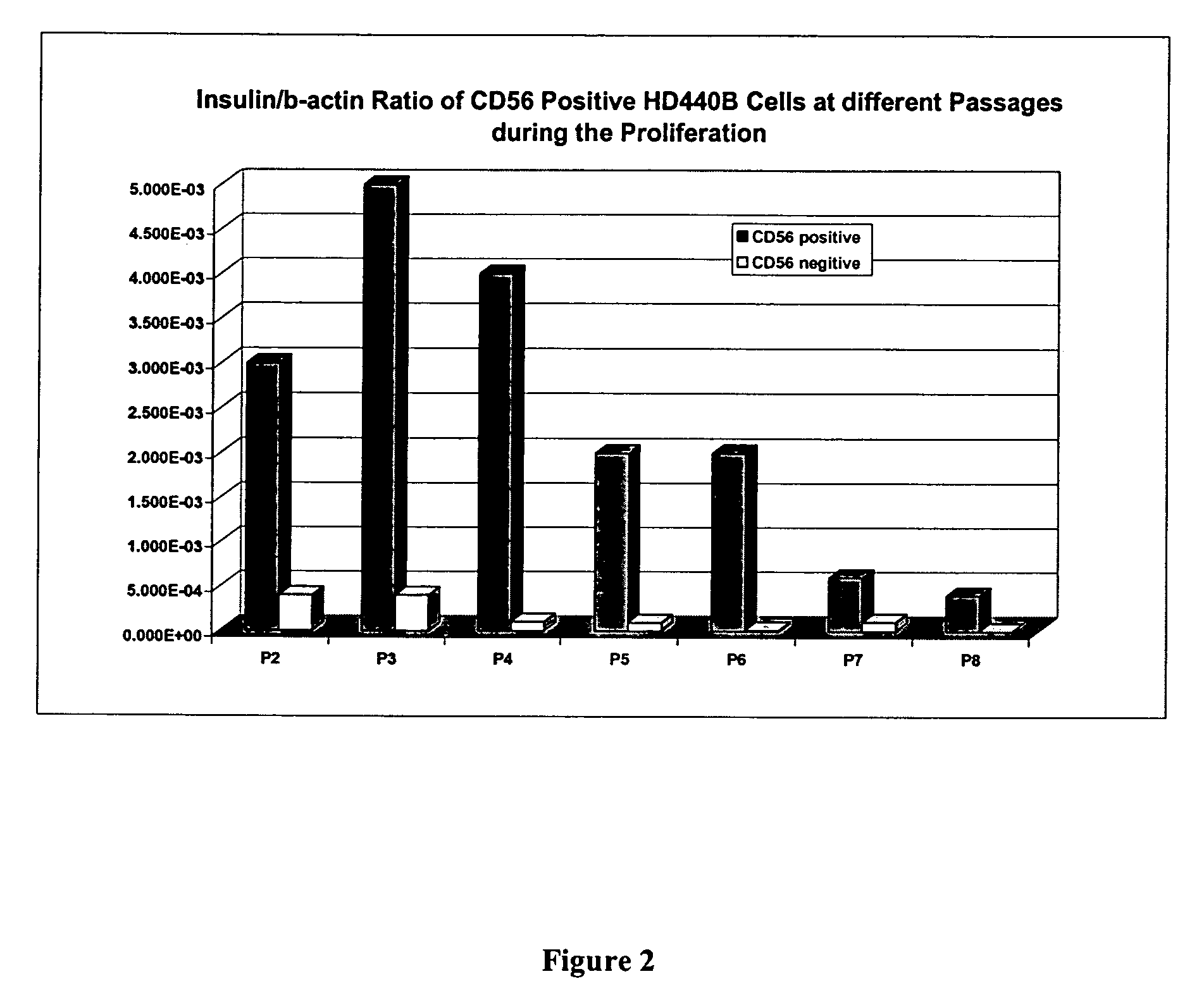CD56 positive human adult pancreatic endocrine progenitor cells
a pancreatic endocrine progenitor cell and human adult technology, applied in the field of selective cell surface markers, can solve the problems of inability of cells to produce endocrine hormones, intracellular markers offer less practical value than extracellular makers,
- Summary
- Abstract
- Description
- Claims
- Application Information
AI Technical Summary
Benefits of technology
Problems solved by technology
Method used
Image
Examples
example 1
Isolation and Initial Culture of Pancreatic Cells (Passage 1 and 2)
[0149]Typically, the CD56 positive pancreatic stem cells are isolated from donor pancreas. A mixed population of isolated pancreatic cells is cultured under conditions to promote the growth of the CD56 positive pancreatic progenitor cells.
[0150]Organ Procurement
[0151]HD407 adult pancreas was harvested from a 20 year old female organ donor. The organ was digested for islet isolation using the following procedure.
[0152]To remove the pancreas from the donor, the abdominal aorta was first cannulated below the junction of renal artery. Portal perfusion was done via cannulation of the inferior mesenteric vein. The cannula was inserted up to and above the junction of the portal vein and the splenic vein. A 2-0 tie was put around the splenic vein at the junction of the portal vein. Another 2-0 tie was put around the splenic artery.
[0153]The splenic vein was ligated and cut open on the spleen side immediately before the perfu...
example 2
Selection of CD56 Positive Cells by FACS Sorting
[0164]Isolated pancreatic cells are first incubated with a CD56 specific antibody, followed by incubation with a fluorescently-labeled secondary antibody, specific for the CD56 specific antibody. Labeled CD56 positive cells are separated from CD56 negative cells by FACS.
[0165]Four dishes of P2 cells were incubated with 0.5% trypsin / 0.2% EDTA (Sigma, T3924) for 5 minutes and washed twice in 4° C. PBS. Cells were then washed through a 40 μM cell strainer. Seven million cells were collected. One million cells were used as an isotype staining control; the rest of the cells were used for FACS sorting.
[0166]Cells were blocked with 50% normal goat serum at 4° C. for ten minutes and then stained with a 1:20 dilution of anti-CD56 antibody as primary antibody (Hybridoma Bank of University of Iowa) for one hour at 4° C. The cells were washed with 4° C. PBS twice to remove nonbinding antibody and then blocked with 50% normal goat serum at 4° C. fo...
example 3
Expansion and Differentiation of CD56 Positive Cells
[0173]CD56 positive cells can be grown and expanded in culture for up to ten passages. CD56 cells can be induced to differentiate by increasing culture time and by growing cells on culture dishes coated with collagen IV. Differentiation factors, e.g., hepatocyte growth factor, keratinocyte growth factor, exendin-4, basic fibroblast growth factor, insulin-like growth factor-I, nerve growth factor, epidermal growth factor and platelet-derived growth factor; can be added to augment the differentiation process.
Cell Expansion
Passage 3
[0174]The FACS-sorted CD56-positive cells were cultured in M7. An estimated 5% of seeded cells attached to the culture dishes after seven days. The cultures were switched to a mixture media of SM95+M7 medias at a 4:1 ratio for three weeks until sub-cultured.
Passage 4
[0175]P3 cells were sub-cultured into a single 1×100 mm culture dish (approximately 8.4×104 cells) on day 28 to become passage 4 (P4) cells. Th...
PUM
 Login to View More
Login to View More Abstract
Description
Claims
Application Information
 Login to View More
Login to View More - R&D
- Intellectual Property
- Life Sciences
- Materials
- Tech Scout
- Unparalleled Data Quality
- Higher Quality Content
- 60% Fewer Hallucinations
Browse by: Latest US Patents, China's latest patents, Technical Efficacy Thesaurus, Application Domain, Technology Topic, Popular Technical Reports.
© 2025 PatSnap. All rights reserved.Legal|Privacy policy|Modern Slavery Act Transparency Statement|Sitemap|About US| Contact US: help@patsnap.com



